LINDERUNG DER KNIEBESCHWERDEN - LAUFEN OHNE SCHMERZEN
Knieschmerzen sind eine häufige Beschwerde, die Menschen jeden Alters treffen kann. Z.B. Folge einer Verletzung, eines Band oder eines Knorpelrisses. Einige Krankheiten wie Arthritis, Gicht und Infektionen können auch Knieschmerzen verursachen.
Viele Arten leichte r Knieschmerzen sprechen gut auf Selbstpflegemaßnahmen wie Physiotherapie an Knie Immobilisierungsgeräte können ebenfalls zur Schmerzlinderung beitragen. In einigen Fällen kann jedoch eine chirurgische Reparatur erforderlich sein.
Zu den Symptomen von Knieschmerzen können gehören:
-
Vorhandensein von Schwellungen, Schmerzen, Empfindlichkeit, Temperatur und sichtbaren Blutergüssen
-
Entzündung und Steifheit
-
Rötung und Temperatur bei Berührung
-
Schwäche oder Instabilität
-
Klicken oder Knacken von Geräuschen
-
Unfähigkeit, das Knie vollständig zu strecken
Risikofaktoren
Es gibt mehrere Faktoren, die das Risiko von Knieproblemen erhöhen, darunter:
-
Übergewicht
-
Mangel an Flexibilität oder Muskelkraft
-
Bestimmte Sportarten und Berufe
-
Vorherige Verletzung
Wie werden Knieschmerzen behandelt?
Während einer körperlichen Untersuchung wird Ihr Arzt wahrscheinlich folgendes empfehlen:
-
Untersuchung des Knies auf Schwellung, Schmerzen, Empfindlichkeit, Temperatur und sichtbare Blutergüsse
-
Prüfung, wie weit Sie den Unterschenkel in verschiedene Richtungen bewegen können
-
Gelenkdruck, um die Integrität der Kniestrukturen zu beurteilen
Treatment
Diese variieren je nach der genauen Ursache der Knieschmerzen.
-
Arzneimittel zur Schmerzlinderung und zur Behandlung bereits bestehender Erkrankungen wie rheumatoider Arthritis oder Gicht.
-
Stärkung der Muskeln um das Knie
-
Injektionen, immer aus der Hand eines Spezialisten.
-
Chirurgischer Eingriff wenn Sie eine Verletzung haben, müssen Sie normalerweise nicht sofort operiert werden. Bevor Sie eine Entscheidung treffen, sollten Sie die Vor- und Nachteile sowohl der nichtchirurgischen Rehabilitation als auch der chirurgischen Rekonstruktion berücksichtigen und dabei entscheiden, was für Sie am wichtigsten ist. Wenn Sie sich für eine Operation entscheiden, stehen folgende Optionen zur Verfügung:
-
Arthroskopische Chirurgie.
-
Teilweise Knieersatzoperation.
-
Totaler Knieersatz.
-
Internes Fach
-
Externes Fach
-
Retropatellarer Bereich
-
FEMORAL COMPONENT, which is the part that inserts into the lower part of the femur.
-
TIBIAL COMPONENT, which is attached to the upper part of the tibia
-
INSERT or INLAY, which is the polyethylene piece attached to the tibial component. It will act as the articular surface with the femoral component.
-
ROTULIAN COMPONENT or ROTULIAN BUTTON, which replaces the articular surface of the patella when the surgeon deems it necessary on a case-by-case basis.
-
INTERNAL or EXTERNAL FEMORAL COMPONENT, which is the part that inserts into the damaged lower femur.
-
INTERNAL or EXTERNAL TIBIAL COMPONENT, which is fixed to the upper part of the tibia
-
INTERNAL or EXTERNAL INSERT or INLAY, a polyethylene piece fixed to the tibial component. It shall act as an articular surface with the femoral component.
-
In the pre-anaesthesia room, the patient is prepared by inserting a peripheral venous line, administering the pre-operative antibiotic and, if necessary, shaving the surgical approach site.
-
In the operating theatre, the anaesthesiologist will administer sedation and spinal anaesthesia, so that the patient does not feel anything during the surgery. In rare cases, general anaesthesia may be used. The anaesthesiologist supervises the patient's condition throughout the operation by regulating and monitoring the patient's vital signs.
-
Once the patient has fallen asleep, a urinary catheter will be placed.
-
On the operating table, the patient will be positioned with the possibility to extend and flex the knee.
-
A longitudinal incision shall be made over the patella 15 cm long in case of total knee replacement or 10 cm long in case of partial knee replacement and deep enough to expose the joint.
-
The articular surfaces of both the tibia and femur of the knee will be exposed and following cutting guides customised to each knee and using a surgical saw, they will be cut. The size of the prosthesis will be determined and stability tests will be carried out.
-
After this check, the tibia and femur components shall be cemented and the insert shall be impacted into the tibial component.
-
After thorough washing of the surgical area, the wound is closed, leaving a drain to evacuate a possible haematoma.
-
Finally, the wound is covered with a sterile dressing and a compressive bandage and the patient is transferred to the resuscitation area until the anaesthesiologist determines when the patient can return to the inpatient ward.
-
The duration of the surgical procedure is approximately 30 minutes to one hour. The patient will be in the operating theatre area from the time he/she enters the pre-anaesthesia area until he/she leaves the resuscitation area when the anaesthesiologist indicates his/her transfer to the ward. Before being taken to the patient's room, a radiological control will be performed by the Radiology Department.
-
2-4 days in case of total knee replacement
-
2-3 days in case of partial knee replacement
-
Booking and use of the operating theatre.
-
Single room with accompanying bed. Food and hospitality for the patient.
-
Complete preoperative study.
-
Post-operative visits until medical discharge.
-
Medical fees.
-
Anaesthesiologist fees.
-
Fees for nursing staff.
-
Surgical material necessary for the operation.
-
Knee prostheses from ZIMMER & DePuy Synthes, world leaders in orthopaedics and traumatology.
-
Anaesthesia, haemotherapy-transfusions, recovery room booking, etc.
-
Medical complications insurance.
Wie läuft eine Knieprothesenoperation ab?
Beim totalen Knieersatz werden die Gelenkflächen des Knies durch eine Metallprothese ersetzt. Das Knie weist eine übermäßige Abnutzung der Gelenkflächen auf, die auf degenerative Erkrankungen oder eine Veränderung der Belastungsachse zurückzuführen ist. Dies führt zu einem Verlust der Beweglichkeit, ständigen Schmerzen und einer fortschreitenden Deformierung, die im weiteren Verlauf zu behindernden Schmerzen und einem Verlust der Lebensqualität führt.
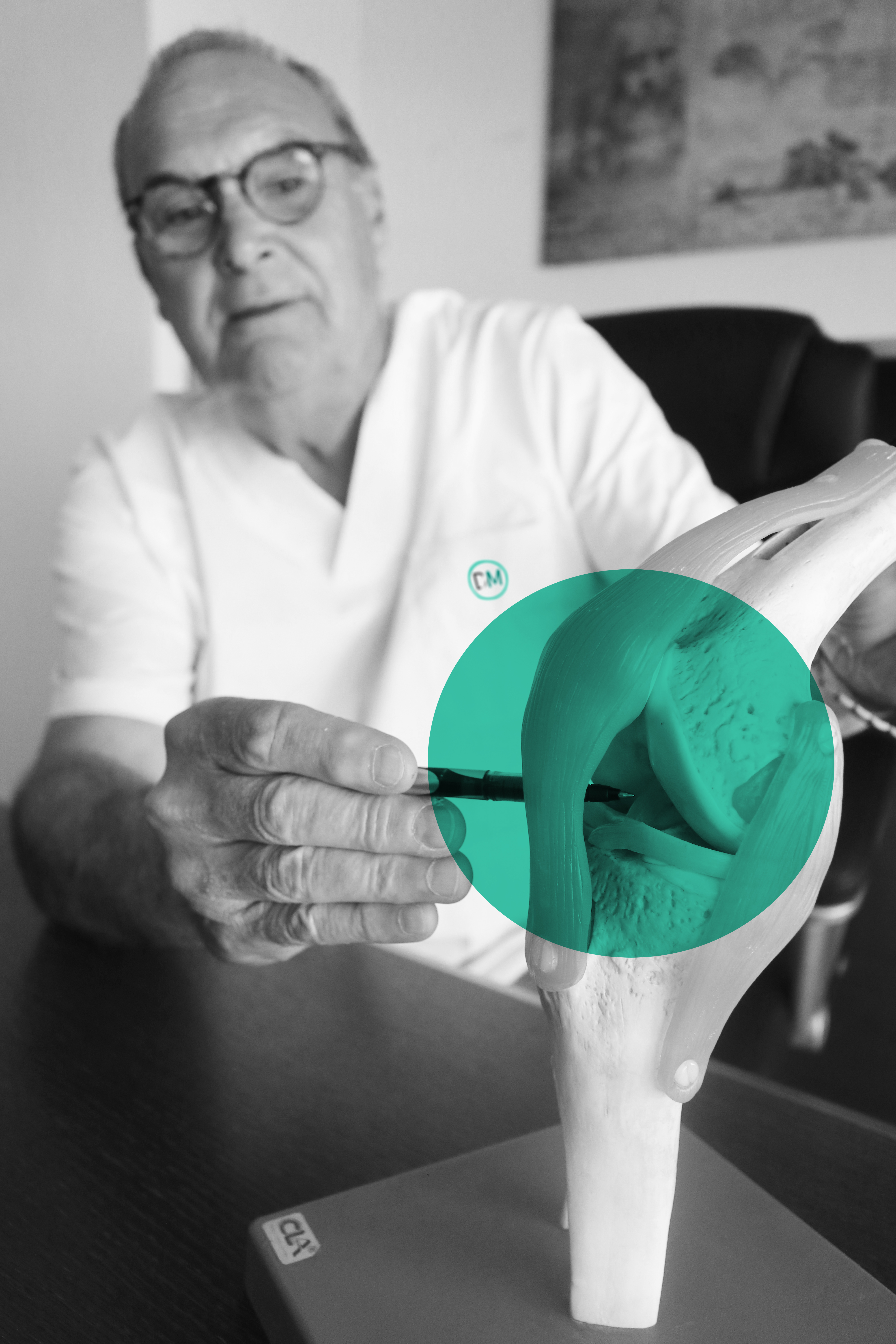
Im Kniegelenk unterscheiden wir drei Kompartimente:
Gelegentlich ist im Knie nur eines der drei Kompartimente betroffen.
In solchen Fällen wird nur die Gelenkfläche des geschädigten Kompartiments ersetzt. In diesem Fall ist der chirurgische Eingriff weniger aggressiv und die Genesung verläuft schneller.
Surgical intervention in which only one joint surface or compartment of the knee is replaced is called partial knee arthroplasty. We distinguish between medial, lateral and retropatellar partial arthroplasty.
What does a knee prosthesis consist of?
The knee prosthesis replaces the original joint that is worn with loss of the articular surface.
The material used is stainless steel or cobalt or chromium alloys with a high density polyethylene intermediate component.
Components of total knee arthroplasty
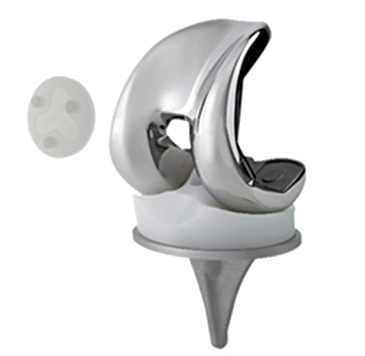
Components of the partial knee arthroplasty:
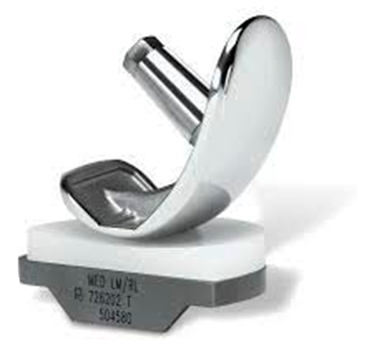
Knee replacement surgery in Palma de Mallorca
Knee replacement surgery requires a protocol that is necessary for the safest and most successful procedure possible.
It is important in this first consultation that the patient provides all the information related to his or her case (X-rays, reports, MRI scans, etc.).
After the physical examination, the indication for total or partial knee arthroplasty will be decided whether or not.
In this first consultation, the patient will be able to ask all the questions he/she may have about the surgical procedure, in order to resolve any doubts and, in this way, make an informed decision about whether or not to undergo knee joint replacement surgery.
Once the decision has been made to carry out the total prosthesis operation in our PROST SURGERY UNIT, an appointment will be made for the preoperative study, as well as the corresponding consultation with our anaesthesiology specialist. Likewise, a date will be set for the surgical intervention.
Preoperative study with Dr. Fernando Muñoz
The tests to be performed in the preoperative study of the total knee replacement operation are an electrocardiogram, a complete blood analysis and a chest X-ray.
The next step is the visit with the anaesthesiologist, who will assess the patient's general condition, pathological history and the risk of anaesthesia, together with the complementary tests carried out. The type of anaesthesia to be applied during the operation will be determined.
Our team will give you preoperative instructions and teach you some breathing exercises to avoid intraoperative and postoperative problems.
Admission and knee replacement surgery
The patient will come to the clinic on the scheduled day. Admission will take place the night before, if the surgery is performed in the morning, or the same day if the hip replacement operation is performed in the afternoon.
Once the corresponding documentation has been handed over, the patient will be accompanied to his or her single room with an accompanying bed, where he or she will remain until the time of the operation. The patient will be showered with a special antiseptic gel and dressed in surgical clothes.
The total knee replacement operation step by step
Ergebnis einer partiellen Kniegelenkersatzoperation:
Vorher und Nachher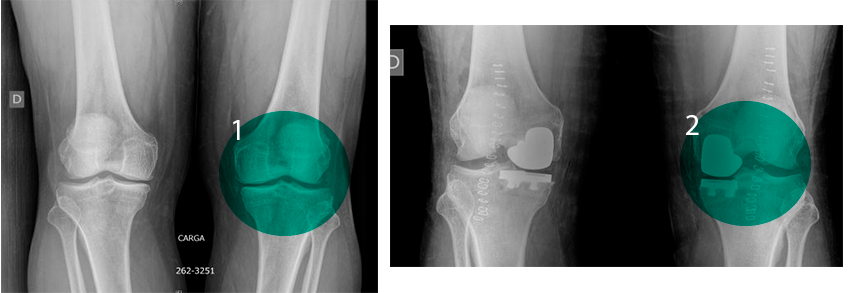
Ergebnis einer Knie-Totalendoprothese:
Vorher und Nachher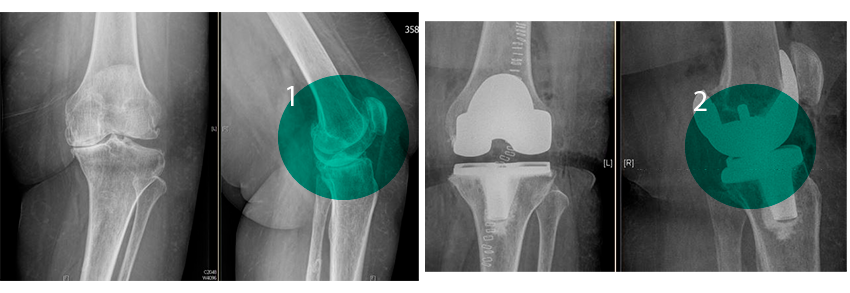
Recovery Phase
From the Radiology Department, the patient is transferred to his or her room on the hospital ward, where he or she will stay for 2 to 4 days in the case of total replacement, or 2 to 3 days in the case of partial replacement.
On the first day after surgery, a new control blood test will be carried out. In the rare case of a drop in haemoglobin, we will use the blood we have in reserve for each patient.
Also on this first day, the bladder catheter and drainage will be removed and the first treatment will be carried out.
From this first day after surgery, the patient will be mobilised with a walker or crutches, and this EARLY MOBILISATION is very important to avoid complications. The patient will be able to progressively load and move the joint.
The Physiotherapy Service will be responsible for teaching the patient to walk with crutches or a walker, so that, on the second or third day, the patient will be able to walk independently and can be discharged from hospital.
It is important to start movement and rehabilitation exercises as soon as possible, as this will significantly shorten recovery times, as well as the possibility of complications.
At home, the patient must continue with daily dressings of the surgical wound, so that after approximately twelve days the staples that close the wound can be removed.
Stay in the clinic:
Duration of surgery: 45 min-1 hour approximately.
Anaesthesia: Rachidian.
Knee prosthesis included: Yes
Full recovery: 3 to 6 months.
Price of a knee replacement operation in Palma de Mallorca
The price of the hip replacement operation by the Prosthetic Surgery Unit with Dr. Fernando Muñoz is closed.
The price for knee replacement surgery is all-inclusive. Below is an overview of what is included:
Wie lange dauert es, sich von einer Knieoperation zu erholen?
Regarding the time to return to work, it will depend directly on the type of work performed. In the case of a sedentary office job, the patient will be able to return to work around 2 months after the surgery, whereas if it is a job that requires significant physical effort, the waiting time can be extended to between 4 and 6 months.
In der Regel hängt die Erholungszeit nach der Kniearthroskopie davon ab, bis die durch die Operation verursachte Entzündung verschwindet.
Der Patient sollte einige Ratschläge befolgen, wie zum Beispiel das Verwenden von Krücken für den Zeitraum, den der Facharzt dies für erforderlich hält.


